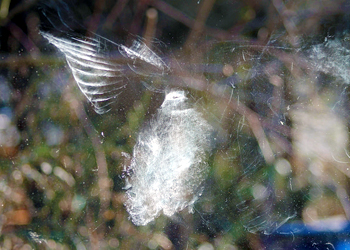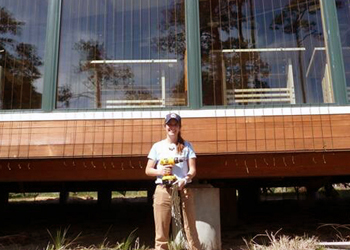Bird Safe Windows

Bird window strike; photo by Jon D. Anderson, Flickr CC by NC ND 2.0
BAM! Have you ever had a bird hit one of your windows?
Nearly a billion birds collide with windows each year, half of which happen with home windows.
Unfortunately, the majority of birds die as a result of their injuries; even those that may be able to fly away often sustain life-threatening injuries. The good news is that window collisions are easy to reduce at many houses.
Why Birds Collide
Birds can collide with glass both during the day and night. Daytime collisions generally occur because the birds see reflections of vegetation in the glass, or the glass appears to be transparent. Birds can also hit windows near feeders if a predator suddenly appears, so it is best to keep feeders close (within 3 feet of a window) or far (more than 30 feet from a window). Occasionally in the spring, birds will also see their reflection in the glass and attack it, also causing collisions.
The reasons for nighttime collisions aren’t fully understood, but many nocturnal migrants navigate using stars and the moon. So, those animals may be lured to your windows due to lighting that mimics their natural guides.
Bird-Safe Glass
Not all windows are equally dangerous to birds, so the first step in deciding what to do is to inventory your windows. Windows that have screens on the outside generally will be avoided, but large windows that reflect vegetation and/or the sky are usually the riskiest for local and migrating birds. Windows close to trees or shrubs sometimes can be an issue as well. Generally, it is best to treat these windows first.
While no measure is 100 percent effective, the following list offers solutions:

Example of Zen curtains outside of Chincoteague National Wildlife Refuge; photo courtesy of the U.S. Fish and Wildlife Service
- Zen Curtains: Zen curtains, also known as Acopian bird-savers, are one of the cheapest ways to create bird-safe glass. The concept employs Para cord strung at 3.5 to 4-inch intervals along a PVC pipe or board placed above the window. The Para cord can either freely hang at the bottom, or you can secure it to another board or pipe. More detailed instructions an d prefabricated bird-savers can be found here.
- Add Screen or Netting: Attach screen or netting at least 2-3 inches from the window. Make sure the area is taut to allow any birds that run into the mesh to bounce off.
- Add a Window Design: Decals or drawing on windows with glass paint or chalk pens can help decrease bird strikes. However, to be the most effective, the decals or the design have to cover the majority of the window. The best designs incorporate the 2×4 rule where the design is spaced out every 2 inches high and 4 inches wide, which is the size of the space most birds will avoid flying through. Note: While drawing with highlighters is effective for a while, by 3-4 days, the pigment is usually unnoticeable to birds.
- Add Tape: Several companies manufacture tape that can be applied to windows in strips or in squares. Some manufacturers, like American Birding Conservancy, make translucent tape that birds can see, but the tape isn’t as apparent to humans. Be sure to pay attention to application guidelines and how long the tape can last outdoors.

Handling an oriole; photo courtesy of Kerry Wixted
What to Do if Strike Occurs
- If the bird is stunned, find a shoebox or paper bag and line the bottom with a paper towel. Gently put the bird inside and place it in a quiet, dark area safe from pets and predators. Do not give the bird food or water and keep the noise and handling to a minimum to reduce stress.
- Always call your local wildlife rehabilitator (regional listings available at https://dnr.maryland.gov/wildlife/Pages/plants_wildlife/rehabilitators.aspx)! These are people with the permits and expertise to take care of your injured bird. Studies have shown that injuries can occur 2-3 days after impact, so it is critical for you to get the bird to help as soon as possible to give it maximum chances of a full recovery. Unable to transport the bird yourself? Give your rehabilitator a call for advice.
- Note: It is illegal to care for a migratory bird without a permit, and rehabilitators are highly trained individuals.
References and Resources
American Birding Conservancy
Bird-friendly Building Guide
Light’s Out Baltimore
Safe Skies, Maryland
Author’s Note
Spring has finally sprung! After a seemingly endless winter, I am excited to welcome warmer temperatures, spring flowers and wildlife into my backyard. This issue includes information on spring visitors like flower flies—a pollinator and a predator—as well as a beautiful native groundcover, moss phlox.
In addition, spring is a time for migration, which can be hazardous for many birds. Check out our article on bird-safe windows for tips on how to make your home more bird-friendly as well as some recommendations by guest author, Clare Walker, on plants that help pollinators but often deter deer.
If there is a particular topic that you would like to include, please don’t hesitate to reach out.
Happy Habitats!
Kerry Wixted
Click here to have HabiChat—the quarterly backyard wildlife habitat newsletter from the Wild Acres program—delivered right to your inbox!
In this Issue:
Bird Safe Windows
Deer Resistant Plants for Pollinators
Flower Flies
Moss Phlox


 1-888-373-7888
1-888-373-7888 233733
233733